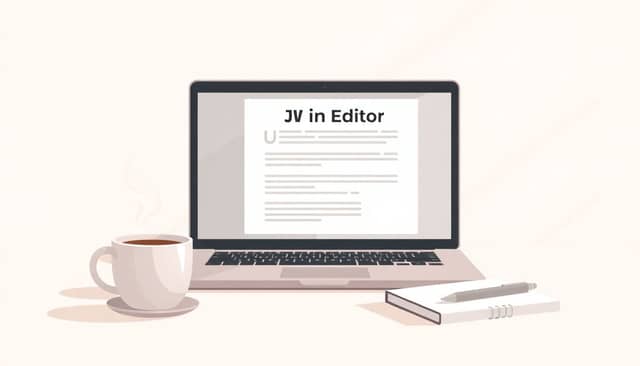Table of Contents
Hiring the right editor can feel overwhelming, especially when you’re not sure how to start or what to look for—we’ve all been there.
But here’s the good news: By following a simple, step-by-step approach, you’ll easily find an editor who totally gets your vision and makes your content shine.
I’ll walk you through exactly how in 10 easy-to-follow steps below.
Key Takeaways
- Know the type of editing you need: developmental for big-picture help, copy editing for sentence clarity, or proofreading for final checks.
- Create a clear job ad detailing what they’ll edit, required experience, your budget, and timeline.
- Share the job posting on specialized platforms like editor associations, freelance sites, and your network.
- Review editor applications by comparing their past projects, style, editing quality, and schedule availability.
- Interview shortlisted candidates, request a paid editing test, and choose the editor who best matches your needs and personality.
- Clearly agree on costs, deadlines, revision terms, and payment details before starting the project.

Step 1: Decide What Type of Editor You Need
The first step when hiring an editor is to get clear on the specific type of editing you actually need—this is going to save you a ton of frustration and money later. Seriously, you’ll thank yourself.
Start by figuring out what stage your writing project is in:
- Developmental editing: If your manuscript is still rough or in its early stages, you probably need someone who can help organize structure, plot, or themes. These editors focus on the big picture rather than tiny details. For example, if you’re crafting a horror story plot, a developmental editor can point out areas where you’re not maintaining tension or where character motivations feel weak.
- Line editing and copy editing: Maybe your manuscript is complete, but it needs polish at the sentence level. Editors who specialize in copy editing and line editing tweak your grammar, spelling, style, and flow to make everything clear and readable. If you’re planning to self-publish your book or share it professionally, this step is crucial.
- Proofreading: A proofreader catches the tiniest technical mistakes—small things that can slip by even the best editors, like punctuation errors or typos. Typically, you’ll hire a proofreader after other editing rounds are complete.
Knowing exactly which type you need helps you budget wisely because each type of editing has a different cost associated. For example, developmental editing usually costs a little more than proofreading since it requires a deeper, structural assessment of your work.
Step 2: Set Clear Requirements for the Editing Job
Alright, now that you know what type of editor you need, let’s talk about setting crystal-clear requirements. Think of it like building your own food order on UberEats rather than randomly picking stuff and hoping for the best. I know, food analogies, right?
Specifically, list out requirements such as:
- Qualifications and experience: Do you want someone who works primarily in fiction, nonfiction, academic, or technical fields? If you’re writing a children’s book, it might be smart to find an editor who knows exactly how children’s books are created.
- Budget limitations: Editors have different pricing structures—hourly rates, per-project fees, or per-word rates. Median annual salaries for editors as of 2023 were about $75,020, which gives a rough idea of industry rates. So, decide upfront what you can realistically afford.
- Deadlines: How fast do you need the edits completed? Good editors often have busy schedules, so knowing your timeline clearly upfront can help eliminate editors who can’t meet your schedule.
- Editing approach and style: Do you want an editor who’s straightforward and direct, or someone softer and more encouraging? You need someone whose personality meshes well so communication is comfortable, clear, and helpful.
Making a simple checklist of these requirements will speed up the selection process and ensure candidates who apply are close matches, saving you hours of weeding through irrelevant resumes.
Step 3: Write a Clear Job Ad for the Editor
Now you’ve decided on the specifics, let’s write an attractive—but clear—job ad. The goal here: be specific enough to attract qualified candidates, without overwhelming everyone with too much detail. Balance is key!
Here’s exactly what you need to include in an effective editor job description:
- Start with the basics: Clearly state the editing role and type, such as “Freelance Developmental Editor for YA Fantasy Novel,” or “Copyeditor Needed for Tech Blog Series.”
- Scope of the job: Explain clearly what they’ll be editing (manuscript length, genre), their expected responsibilities, and the exact editing type required (proofreading, developmental, etc.).
- Experience level: Clearly state if you’re looking for industry vets or newer editors who might have lower rates but less experience.
- Preferred qualifications: Mention anything specific you’re looking for—like experience in your book genre, knowledge about particular styles (APA style, Chicago Manual of Style), familiarity with certain software or publishing conventions, or experience with self-publishing.
- Compensation details: Including budget information or expected pay ranges upfront helps editors decide whether to apply. Remember, transparent ads typically yield better matches.
- How to apply: Be clear about the application process. Want them to submit specific examples of previously edited work? Interested in references? Define these clearly to save time later.
Let’s say you’re hiring an editor for your dystopian YA novel. You might mention you’re particularly looking for someone with experience in dystopian fiction who can help strengthen tensions, theme, and pacing—maybe someone familiar with the pacing techniques of successful modern dystopian books. Editors familiar with the techniques used in resources like this dystopian plot generator might have exactly the experience you need.
A clear job ad makes the rest of your hiring process smoother because it attracts only editors who genuinely fit your needs—creating less hassle for you later on.

Step 4: Post Your Job Ad on Relevant Platforms
Once you’ve crafted your clear and appealing job ad, you’ll need to post it somewhere editors can actually see it.
Instead of randomly posting and hoping for the best, check out the most effective spots for hiring editors who genuinely fit your requirements:
- Editing associations and groups: Professional associations like the Editorial Freelancers Association (EFA) or specialized LinkedIn groups attract experienced editors actively seeking jobs.
- Freelance platforms: Sites like Upwork, Fiverr, and Freelancer have thousands of editors available for hire. These platforms make it easy to see reviews and portfolio samples upfront.
- Job boards specifically for publishing and content creation: Websites like MediaBistro focus on creative roles, bringing in targeted applicants rather than generic responses.
- Your own networks and social media: Don’t underestimate simply posting your editor job ad on your personal pages like LinkedIn, Twitter, or even Facebook. Someone in your circle might know the perfect candidate.
Since there are currently around 74,471 editors employed in the U.S., you’re tapping into a big pool of talent across media, education, professional industries, and more.
With around 15,115 open editor job postings right now, competition for skilled editors can be intense, so it’s in your best interest to act quickly once candidates apply.
Step 5: Review Editor Applications Carefully
After posting your ad, you’ll start receiving applications fairly quickly—and now it’s time to sift through them like a pro rather than just winging it.
Here’s a quick way to handle this efficiently:
- Narrow down based on requirements: Immediately filter out any applications that clearly don’t meet your stated requirements from step two (experience, style, timelines, etc.).
- Rank applications into tiers: Separate the strong fits, possible fits, and definite no’s. This helps you avoid getting overwhelmed and keeps things manageable.
- Evaluate editor work history and past clients: Check out resumes thoroughly—did this person do similar projects before? Do their past experiences match your genre or project type? For example, someone experienced in helping authors get published without an agent might bring valuable insight to your indie or self-publishing project.
- Read through provided editing samples: Look for attention to detail, clarity of suggestions, and overall edit quality. Does it improve the text significantly?
With the job market projected to decline by around 2% through 2033, editors actively looking for work are often highly motivated and skilled—particularly freelance editors replacing roles lost elsewhere—so you might spot some gems by simply reviewing applications carefully.
Step 6: Interview Potential Editors
Once you’ve shortlisted your favorite candidates, interviewing personally will let you determine if an applicant truly fits your needs and personality.
Set up a quick video call—no need to be overly formal—and ask targeted questions like:
- “Can you describe your editing process start-to-finish?”
- “Tell me about a challenge you faced with editing similar material, and how you solved it.”
- “How do you handle feedback and revisions?”
- “What’s your typical turn-around time for a project like mine?”
By asking concrete questions, you’ll get an honest sense of how the working relationship would go and can judge their expertise quickly.
Editors generally work independently and remotely, so interviewing personally helps ensure clear, comfortable communication right from the start.
Step 7: Request Editing Samples or Tests
Even after seeing applicants’ previous editing samples, it’s a smart move to ask them to perform a short, paid editing test specific to your project.
Provide a small excerpt (like 500–1,000 words) and request candidates edit it exactly as they would your finished manuscript.
Why do this extra step? Because nothing shows the editor’s value clearer than real, hands-on work.
Make sure you pay for any test editing—it shows professionalism and respect for their time.
Step 8: Compare Backgrounds, Skills, and Fit
Once you have their editing test results, it’s decision-making time.
Evaluate candidates clearly and simply by focusing on three key areas:
- Editing quality: Did their test make the text clearer, stronger, and more readable?
- Background and experience: Does their past work align closely with your project type, style, or publishing goals?
- Chemistry and communication: Was interacting with the editor easy and helpful? Could you picture working with them long-term?
If you’re writing something specific such as a graphic novel or trying to create an interactive ebook, make sure the candidate matches the niche and complexity of your project needs.
Doing this thorough evaluation makes picking an editor far less risky and ensures a good partnership.
Step 9: Agree on Rates and Editing Terms
You found your perfect editor—now what?
Before jumping in, clearly agree in writing on:
- Rates: Editors vary; median salaries sit around $75,020 per year as of 2023, though freelance hourly or per-word rates differ widely. Be transparent about expectations and budget right away.
- Timeline: Set clear deadlines from the start to avoid confusion and delays.
- Revisions factor: Will your rate include revisions or will additional changes require extra fees?
- Payment schedule: Will you pay upfront, halfway, or upon project completion?
If your editor uses software or proofreading tools, discuss that as well to make sure you’re both comfortable with methods and expectations.
Step 10: Finalize Hiring and Set Up Onboarding
Now you’re officially ready to hire and get going with your chosen editor—awesome!
Quick onboarding tips to start off smoothly:
- Provide clear manuscript files in the required format, and any specific style guidelines or expectations you have.
- Have a quick follow-up call or Zoom chat to ask/answer remaining questions or concerns.
- Outline preferred communication methods and frequency of check-ins.
If you’re new to book publishing, this might also be the perfect time to look into other important aspects like how to format dialogue or to get familiar with the difference between paperback and hardback editions—all pieces of the publishing process your editor might assist with or advise you on.
Your preparation upfront makes this onboarding quick, straightforward, and stress-free, setting the tone for a productive, enjoyable collaboration.
FAQs
Determine your project’s scope, required editing skills, deadlines, and budget clearly. Specify your expectations such as copyediting, proofreading, structural edits, or fact-checking, to ensure you find the editor best fit to meet your project’s goals and timeline.
You can publish job listings on platforms like LinkedIn, Indeed, or specialized sites for freelancers, editors, and writers such as Upwork or Editorial Freelancers Association. Posting on targeted industry forums or networking groups can also help attract suitable candidates efficiently.
Request editing samples reflecting your project’s style, genre, or tone. Alternatively, provide applicants with a short piece to edit as a test. This approach helps you accurately assess their editing capability, attention to detail, consistency, and suitability for your specific job.
Research industry standards, check editing association guidelines, or inquire about candidates’ previous fees. Consider level of experience, project complexity, turnaround time, and scope. Clarify whether rates are hourly, per-word, or project-based for transparency and mutual clarity on the payment terms.



